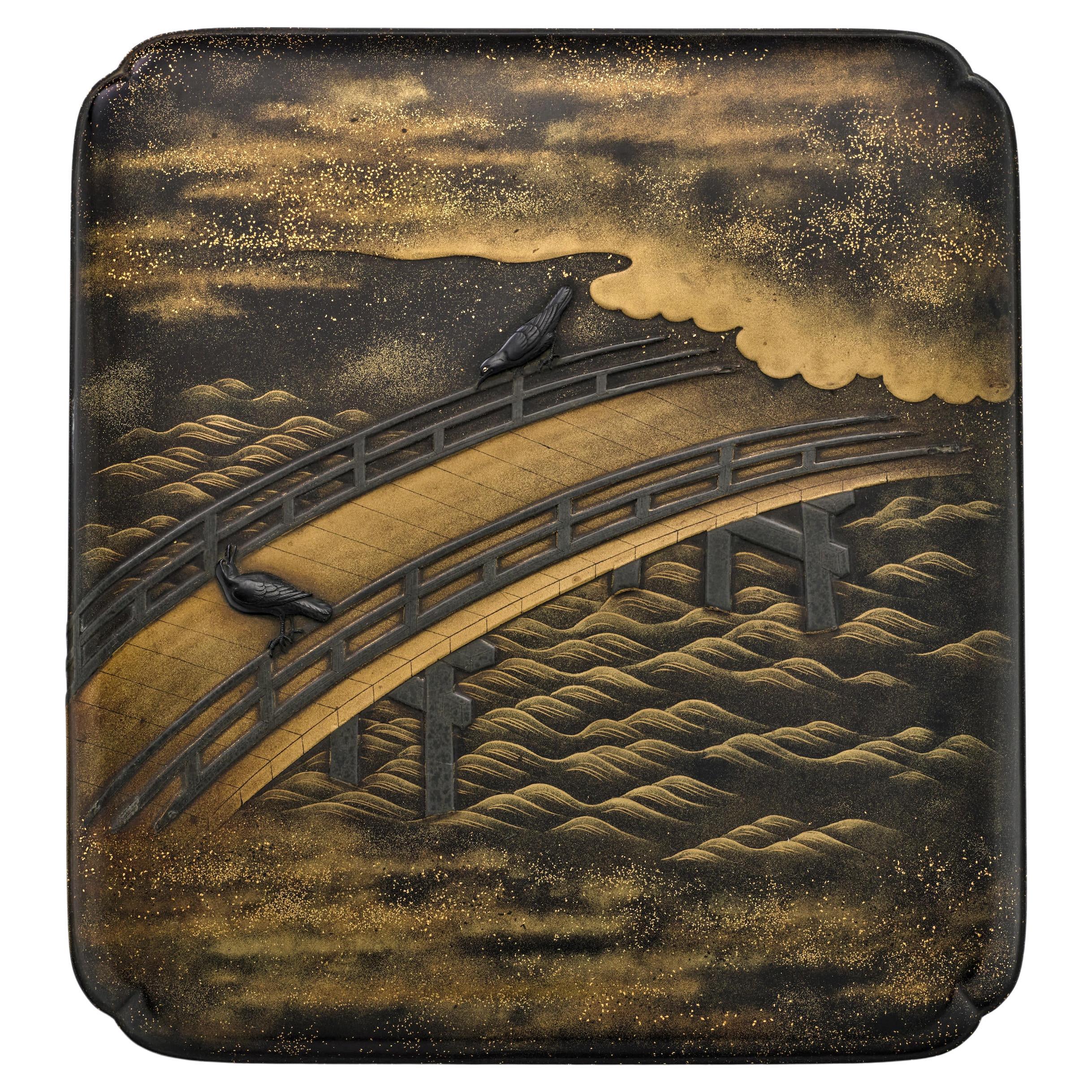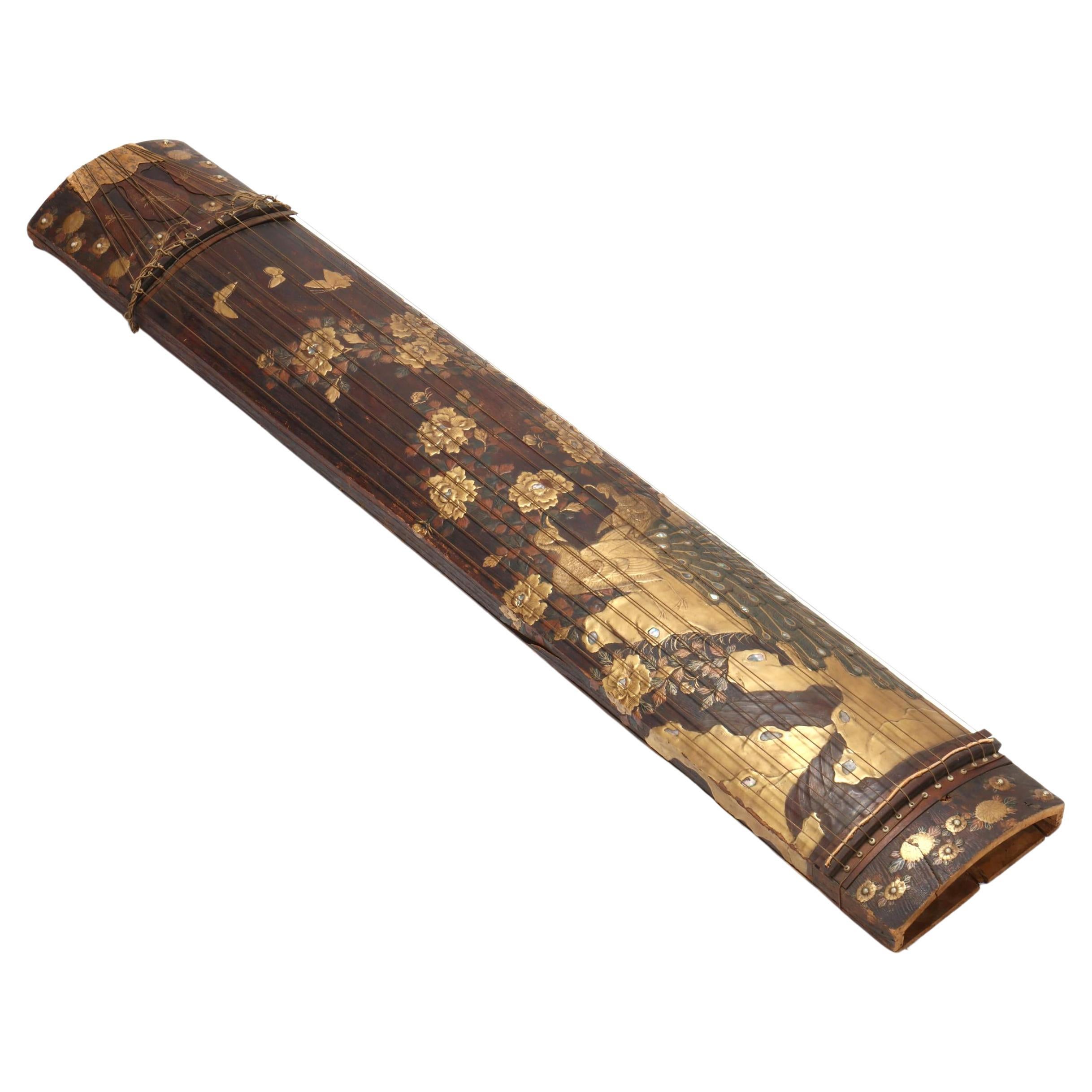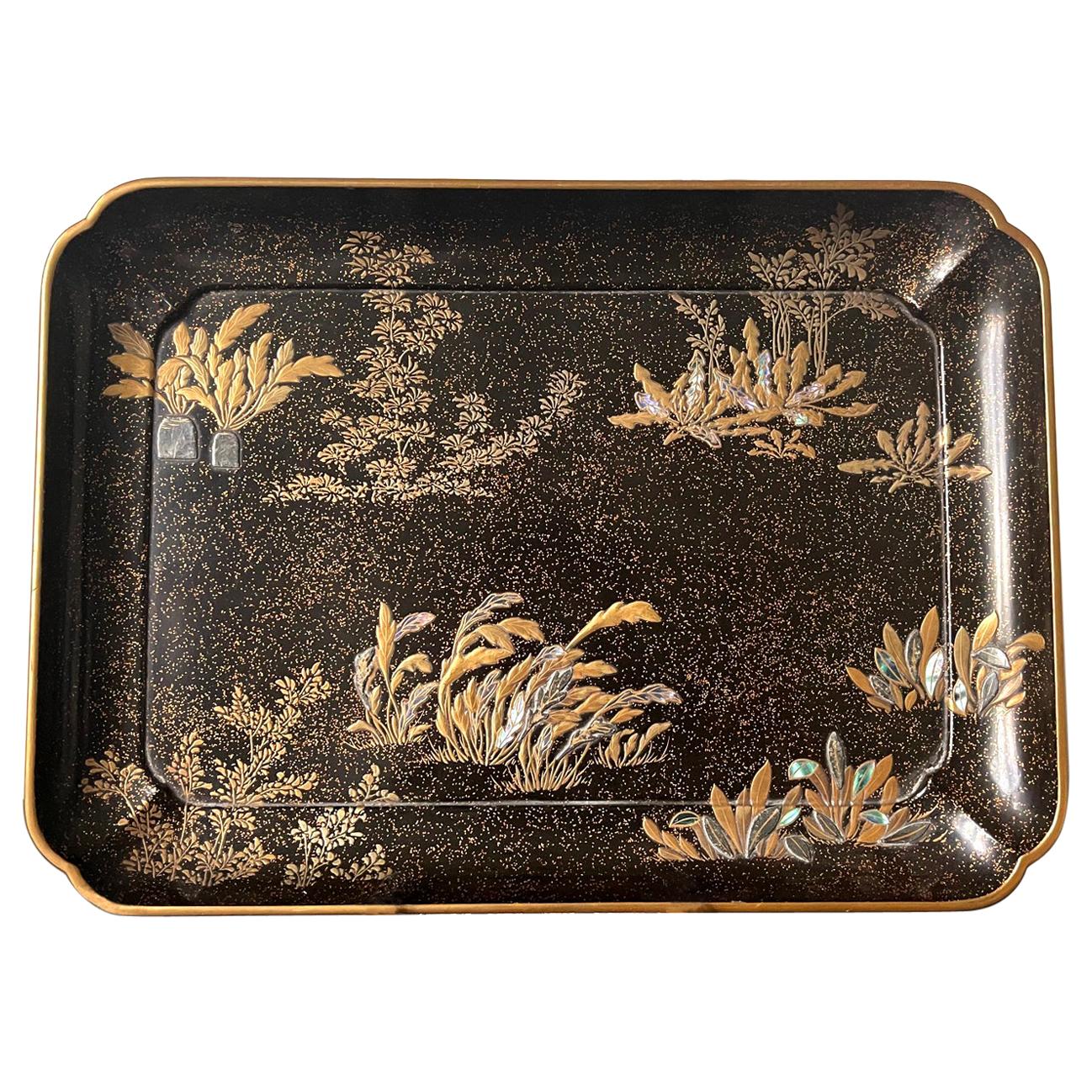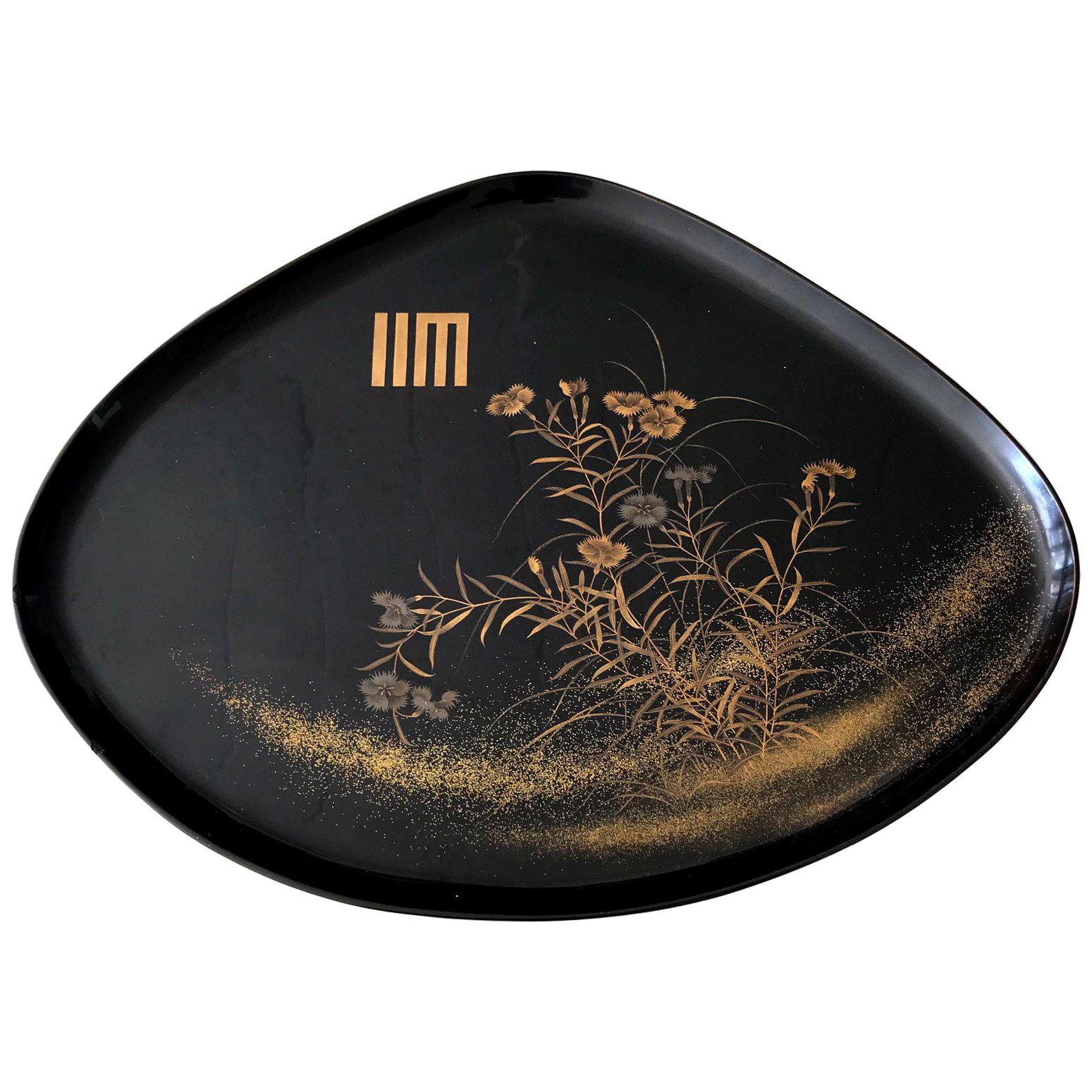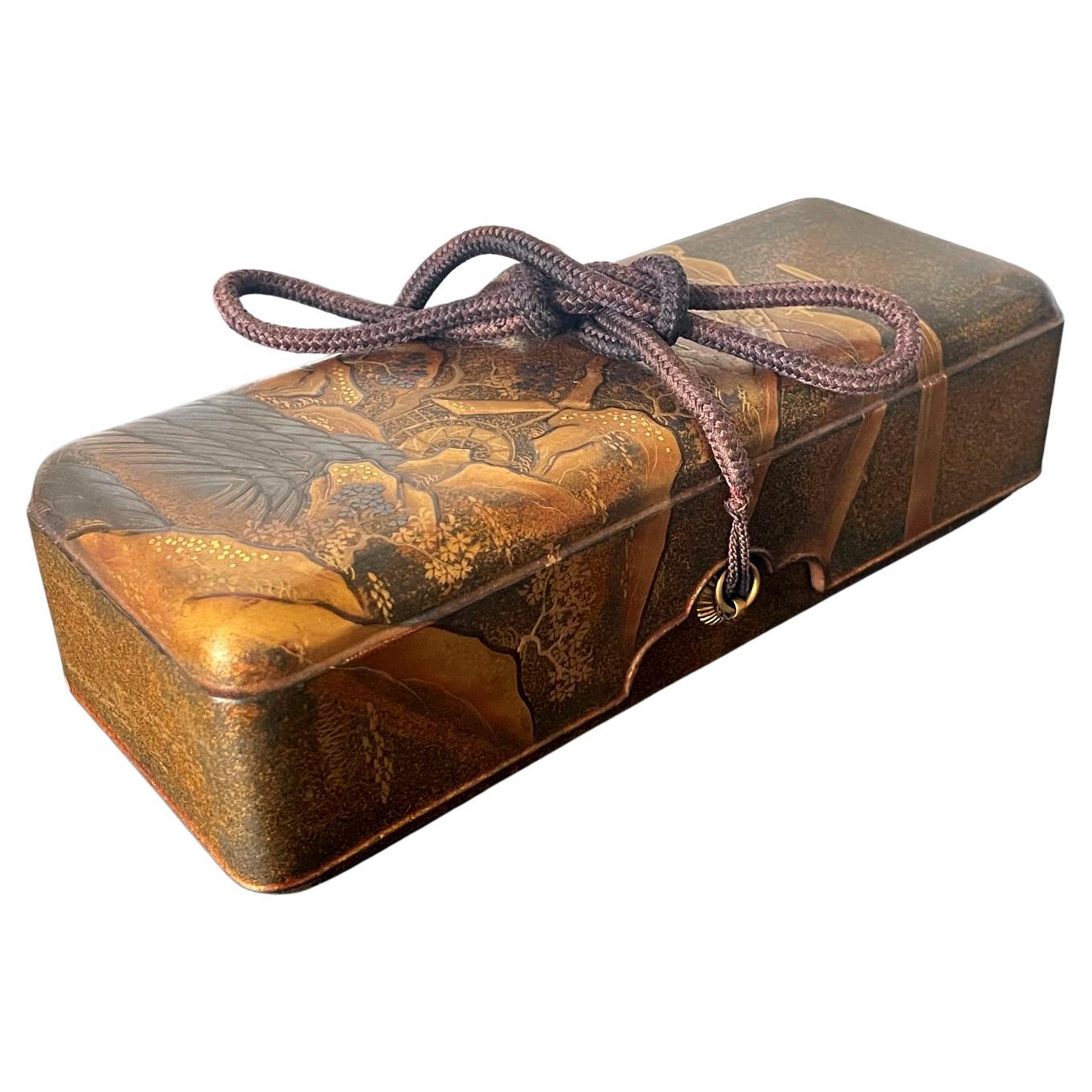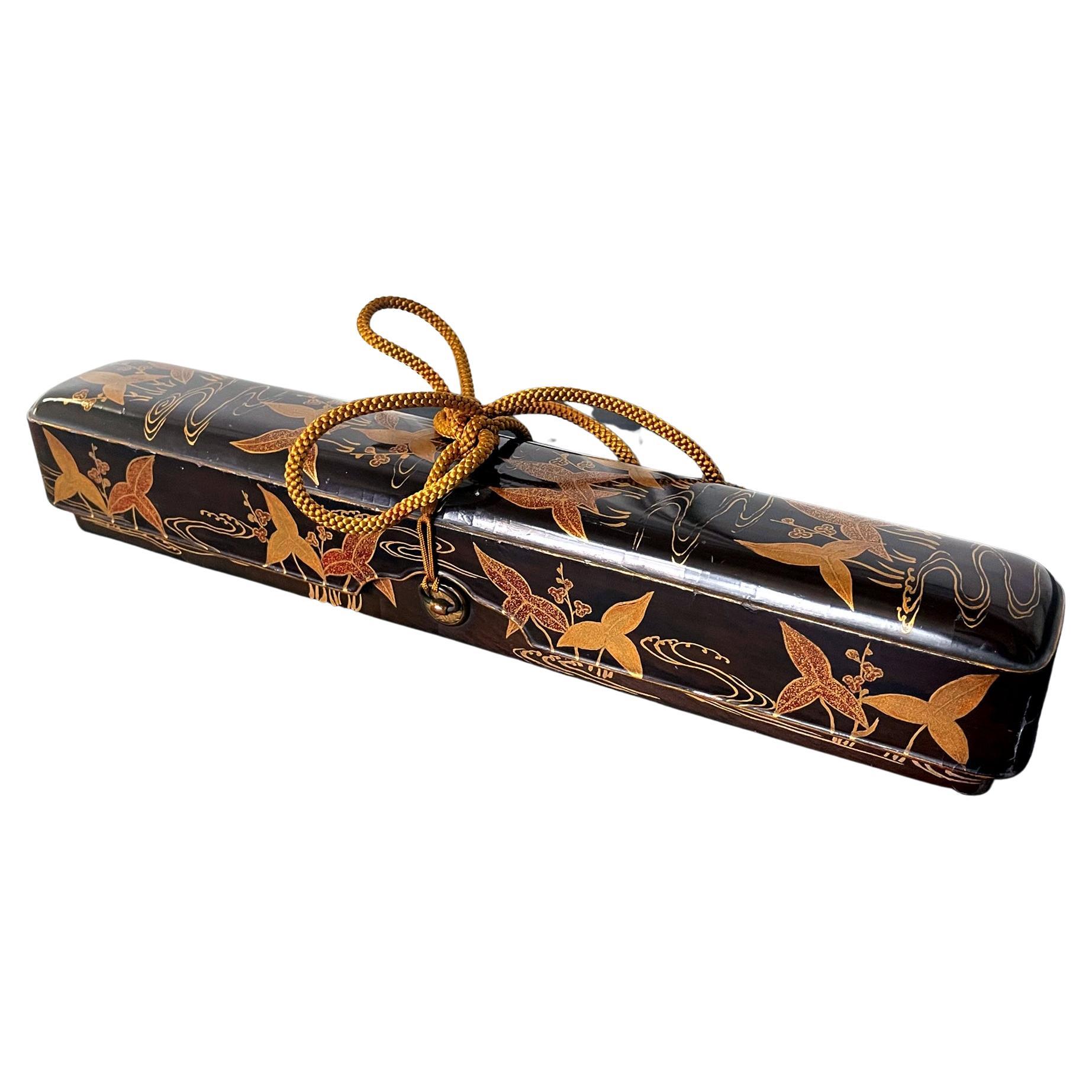Items Similar to Unique Japanese Lacquer Maki-e Suzuribako with Woven Bamboo Cover with Tomobako
Want more images or videos?
Request additional images or videos from the seller
1 of 21
Unique Japanese Lacquer Maki-e Suzuribako with Woven Bamboo Cover with Tomobako
About the Item
This Japanese suzuribako (ink box) of late Meiji Period (circa end of 19th century) is uncommon with its surface covered with woven basketry in chevron pattern. Once opened, the viewer is struck with a splendid Maki-e interior decoration in sharp contrast with the plain exterior. With masterful composition and in great and fine details, the decoration under the cover depicts a tranquil nocturnal scenery. Under a full moon among shifting clouds, a fenced thatched roof hut sits under a blooming camellia tree behind rock outcrops by the edge of the water. Hira and takamaki-e were used effectively with kirigane and silver inlays to create a poetic and dimensional image. The workmanship is superb, showing a full mastery of the techniques. The motif continues to the other side of the interior with a brush compartment that features two knotty pines on rocks, and a tray for a removable ink stone and a silver handled waterdrop (suiteki). Extraordinarily, the suzuibako retains a set of five writing instrument in gold lacquer finish and silver ornament. This includes a matching set of two brush pens, a paper knife and a paper pricker and an ink stick inscribed Kyukyodo, which was founded in 1663 and was the official stationer supplier to the imperial house from 1891 to 1945. It is uncommon for a suzuribako to retain its writing accoutrement. The rest of the interior and the base were finished in a dense "pear-skin" nashiji. The rim of the box is lined with a metal rim (appears to be zinc) that shows even aged patina.
The original tomobako storage box measures 10.5" x 8.5" x 4" and it retains two paper labels in Kanji indicating its content. It is translated as "Suzuribako with woven surface; Rock over Waves Internal Maki-e on Nashji background". There is also a red cotton pad for interior protection and a brocade wrapping cloth. A rare and complete set.
- Dimensions:Height: 1.75 in (4.45 cm)Width: 7.25 in (18.42 cm)Depth: 9.25 in (23.5 cm)
- Style:Japonisme (Of the Period)
- Materials and Techniques:
- Place of Origin:
- Period:
- Date of Manufacture:Late 19th-Early 20th Century
- Condition:Wear consistent with age and use. Fine condition with minor wear mostly on the edge and base corners. Aged patina and silver oxidation as expected. Lid is very slightly warped when fitting. Tomobako with overall wear due to age.
- Seller Location:Atlanta, GA
- Reference Number:1stDibs: LU945026996372
About the Seller
5.0
Platinum Seller
These expertly vetted sellers are 1stDibs' most experienced sellers and are rated highest by our customers.
Established in 2006
1stDibs seller since 2010
483 sales on 1stDibs
Typical response time: <1 hour
- ShippingRetrieving quote...Ships From: Atlanta, GA
- Return PolicyA return for this item may be initiated within 2 days of delivery.
More From This SellerView All
- Exquisite Japanese Lacquer Maki-e Suzuribako by Koma Kyūhaku Edo PeriodLocated in Atlanta, GAOne of the finest Japanese Maki-e Suzuribakos (ink box) we have on offer, the roiro color box showcases an ambient nocturnal scene in which two shakudo inlaid crows perched on the handrails of a bridge (possible the Uji Bridge...Category
Antique Early 19th Century Japanese Japonisme Lacquer
MaterialsStone, Metal
- Japanese Meiji Han Koto with Maki-e Lacquer DecorationLocated in Atlanta, GAA rare Japanese Koto made from carved Paulownia wood and lavishly decorated with lacquer Maki-e circa late 19th century of Meiji Period (1868-1912). The ...Category
Antique Late 19th Century Japanese Japonisme Lacquer
MaterialsWood
- Japanese Lacquer Tray with Maki-e and Inlay Hara Yoyusai Edo PeriodLocated in Atlanta, GAA lovely Japanese lacquer rectangular lacquer tray with a slightly scalloped corner and four L shape supporting feet by one of the most celebrated lacquer artist active in Edo period Hara Yoyusai (1772-1845). Yoyusai lived in Edo (Tokyo) and worked under the patronage of Lord Matsudaira. He operated a large workshop and had a very prolific output of lacquer objects. Most survived pieces being inro...Category
Antique 19th Century Japanese Japonisme Lacquer
MaterialsWood, Lacquer
- An Antique Japanese Lacquer Maki-e TrayLocated in Atlanta, GAA fan shape black lacquer tray from Japan circa 1910-30s, late Meiji to early Showa era. Elaborated decorated with a bundle of yomogi blossom in a very fine Maki-e technique using both gold and silver powders. There is a Japanese symbol on the top left, which represents yomogiu, stemming from yomogi (蓬), a wild plant that belongs to the chrysanthemum family and widely grown in Japan. This name yomogui is from a scene in the Tale of Genji...Category
Early 20th Century Japanese Japonisme Lacquer
MaterialsLacquer
- Japanese Lacquered Maki-e Fubako Edo PeriodLocated in Atlanta, GAA Japanese lacquered wood fubako (a box used to store document or small scroll painting), circa second half of 19th century late Edo period. The rectangular box features an unusually deep lipped lid with slightly rounded corners, a conforming lower box that is almost entirely covered by the lid which has two bronze medallion rings with tasseled...Category
Antique 19th Century Japanese Edo Lacquer
MaterialsWood, Lacquer
- Japanese Lacquered Maki-E Fubako in Kodaiji StyleLocated in Atlanta, GAA rare Japanese lacquered wood fubako decorated in Kodaiji maki-e style circa early 17th century the beginning of the Edo period, possibly early toward the end of the Azuchi-Momoyama period. The rectangular, long and slim box features a deep lipped lid with slightly rounded corners, a conforming lower box with two bronze medallion rings with tasseled...Category
Antique Early 17th Century Japanese Edo Lacquer
MaterialsWood, Lacquer
You May Also Like
- Antique Gold/Opium Bamboo Scale with Built-In Abacus, Chinese, 19th CenturyLocated in Point Richmond, CAAntique gold/opium bamboo scale with built-in abacus, Chinese, 19th century Fitted into a bamboo case are a brass tray with bronze weights and a bone beam with measuring marks. Th...Category
Antique 19th Century Chinese Folk Art Scholar's Objects
MaterialsBamboo
- Japanese Old Scholar's Stone / Odd Shaped Appreciation Stone / SuisekiLocated in Sammu-shi, ChibaThis is a stone mined in Japan. Not only in China but also in Japan from ancient times, rocks in the mountains have been shaved and stones for v...Category
Early 20th Century Japanese Taisho Scholar's Objects
MaterialsStone
- Old Japanese Scholar's Stone / Beautiful Appreciation Stone/Natural StoneLocated in Sammu-shi, ChibaThis is a stone mined in Japan. Measure: w 22cm. Not only in China but also in Japan from ancient times, rocks in the mountains have been shaved and stones for viewing have been qua...Category
Early 20th Century Japanese Showa Scholar's Objects
MaterialsStone
- Rare Chinese Alms Jade Globular Shape Bowl with Relief Panels of FruitLocated in New York, NYA quite rare 18-19th century Chinese hand carved globular shape alms jade bowl, hand carved with relief panels of sacred fruit. With a beautiful celadon color, this jade bowl has bee...Category
Antique Early 1800s Chinese Scholar's Objects
MaterialsJade
- Japanese Woven Bamboo Tabako-bon, c. 1900Located in Chicago, ILThis woven basket is actually a Japanese tabako-bon, or 'tobacco tray,' used as a portable hibachi for lighting tobacco pipes. Believed to have evolved from the traditional accessories of Japanese incense ceremony, tabako-bons first came into use in the 17th century and were often beautifully decorated to display one's wealth and status. This tabako-bon is woven of smoked bamboo and features a ceramic...Category
Early 20th Century Japanese Meiji Decorative Baskets
MaterialsCeramic, Bamboo
- Large Zitan Huanghuali Hardwood Brush Pot Bitong, Qing Dynasty, ChinaLocated in Brooklyn, NYLarge Zitan Huanghuali hardwood brush pot bitong, Qing Dynasty, 18th century, China Measures: Height 12 diameter 12.75 in.Category
Antique 18th Century Chinese Qing Scholar's Objects
MaterialsZitan
Recently Viewed
View AllMore Ways To Browse
Woven Bamboo
Unique Bamboo Furniture
Japanese Woven
Japanese Brush
Japanese Brushes
Antique Japanese Bamboo
Japanese Rattan Furniture
Japanese Rattan
Rattan Japan
Japanese Labels
Scholar Stone
Japanese Lacquer Set
Japanese Cloth Art
Asian Pear
Asian Pears
Japanese Roof
19th Century Japanned Bamboo
Lacquered Metal Tray
